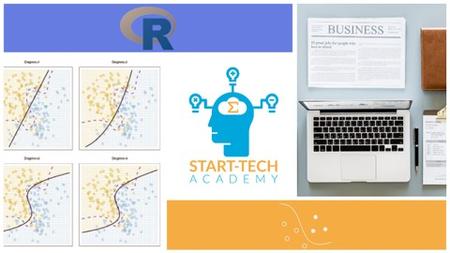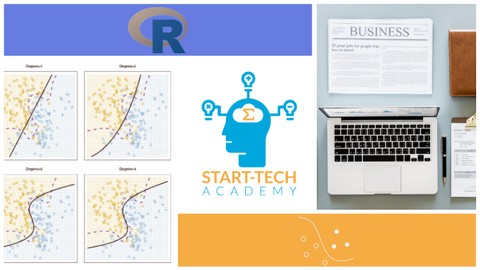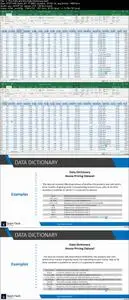Machine Learning Basics: Classification models in R
.MP4 | Video: 1280x720, 30 fps(r) | Audio: AAC, 44100 Hz, 2ch | 2.18 GB
Duration: 5 hours | Genre: eLearning Video | Language: English
.MP4 | Video: 1280x720, 30 fps(r) | Audio: AAC, 44100 Hz, 2ch | 2.18 GB
Duration: 5 hours | Genre: eLearning Video | Language: English
Use classification to solve business problems and master the basics of Machine Learning classification in R.
What you'll learn
Understand how to interpret the result of Logistic Regression model and translate them into actionable insight
Learn the linear discriminant analysis and K-Nearest Neighbors technique
Learn how to solve real life problem using the different classification techniques
Preliminary analysis of data using Univariate analysis before running classification model
Predict future outcomes basis past data by implementing Machine Learning algorithm
Indepth knowledge of data collection and data preprocessing for Machine Learning logistic regression problem
Course contains a end-to-end DIY project to implement your learnings from the lectures
Graphically representing data in R before and after analysis
How to do basic statistical operations in R
Requirements
Students will need to install R and R studio software but we have a separate lecture to help you install the same
Description
The course "Machine Learning Basics: Classification models in R" teaches you all the steps of creating a Classification model to solve business problems.
Below is a list of popular FAQs of students who want to start their Machine learning journey-
What is Machine Learning?
Machine Learning is a field of computer science which gives the computer the ability to learn without being explicitly programmed. It is a branch of artificial intelligence based on the idea that systems can learn from data, identify patterns and make decisions with minimal human intervention.
Which all classification techniques are taught in this course?
In this course we learn both parametric and non-parametric classification techniques. The primary focus will be on the following three techniques:
Logistic Regression
Linear Discriminant Analysis
K - Nearest Neighbors (KNN)
How much time does it take to learn Classification techniques of machine learning?
Classification is easy but no one can determine the learning time it takes. It totally depends on you. The method we adopted to help you learn classification starts from the basics and takes you to advanced level within hours. You can follow the same, but remember you can learn nothing without practicing it. Practice is the only way to remember whatever you have learnt. Therefore, we have also provided you with another data set to work on as a separate project of classification.
What are the steps I should follow to be able to build a Machine Learning model?
You can divide your learning process into 3 parts:
Statistics and Probability - Implementing Machine learning techniques require basic knowledge of Statistics and probability concepts. Second section of the course covers this part.
Understanding of Machine learning - Fourth section helps you understand the terms and concepts associated with Machine learning and gives you the steps to be followed to build a machine learning model
Programming Experience - A significant part of machine learning is programming. Python and R clearly stand out to be the leaders in the recent days. Third section will help you set up the Python environment and teach you some basic operations. In later sections there is a video on how to implement each concept taught in theory lecture in Python
Understanding of models - Fifth and sixth section cover Classification models and with each theory lecture comes a corresponding practical lecture where we actually run each query with you.
Why use R for Machine Learning?
Understanding R is one of the valuable skills needed for a career in Machine Learning. Below are some reasons why you should learn Machine learning in R
1. It’s a popular language for Machine Learning at top tech firms. Almost all of them hire data scientists who use R. Facebook, for example, uses R to do behavioral analysis with user post data. Google uses R to assess ad effectiveness and make economic forecasts. And by the way, it’s not just tech firms: R is in use at analysis and consulting firms, banks and other financial institutions, academic institutions and research labs, and pretty much everywhere else data needs analyzing and visualizing.
2. Learning the data science basics is arguably easier in R. R has a big advantage: it was designed specifically with data manipulation and analysis in mind.
3. Amazing packages that make your life easier. Because R was designed with statistical analysis in mind, it has a fantastic ecosystem of packages and other resources that are great for data science.
4. Robust, growing community of data scientists and statisticians. As the field of data science has exploded, R has exploded with it, becoming one of the fastest-growing languages in the world (as measured by StackOverflow). That means it’s easy to find answers to questions and community guidance as you work your way through projects in R.
5. Put another tool in your toolkit. No one language is going to be the right tool for every job. Adding R to your repertoire will make some projects easier – and of course, it’ll also make you a more flexible and marketable employee when you’re looking for jobs in data science.
What is the difference between Data Mining, Machine Learning, and Deep Learning?
Put simply, machine learning and data mining use the same algorithms and techniques as data mining, except the kinds of predictions vary. While data mining discovers previously unknown patterns and knowledge, machine learning reproduces known patterns and knowledge—and further automatically applies that information to data, decision-making, and actions.
Deep learning, on the other hand, uses advanced computing power and special types of neural networks and applies them to large amounts of data to learn, understand, and identify complicated patterns. Automatic language translation and medical diagnoses are examples of deep learning.
Who this course is for:
People pursuing a career in data science
Working Professionals beginning their Data journey
Statisticians needing more practical experience





